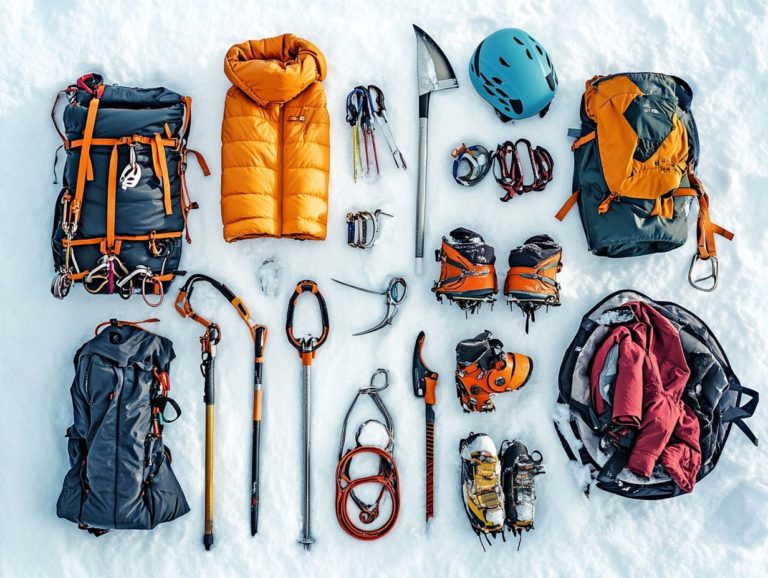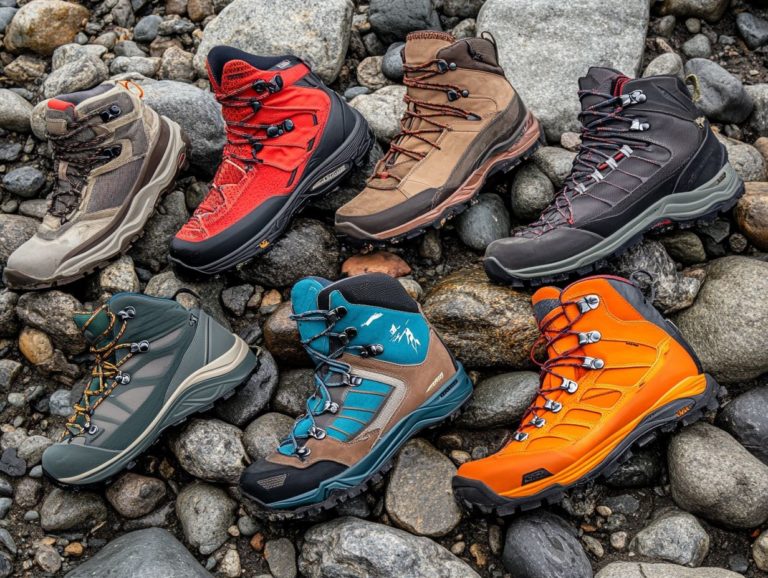What is the Importance of Outdoor Gear Testing?
When it comes to your outdoor adventures, having dependable gear can be the key to transforming a challenging experience into a truly memorable one.
Engaging in outdoor gear testing is essential for ensuring that your equipment meets both safety and performance standards. This article also addresses critical safety considerations to guarantee accurate and secure testing practices. Join us to explore the essential aspects of outdoor gear testing that every enthusiast should be well-acquainted with!
Contents
Key Takeaways:

- Outdoor gear testing is vital for your safety and gear quality don’t hit the trails without it!
- The gear testing process involves careful steps and methods to accurately evaluate the performance and durability of outdoor gear.
- Both consumers and manufacturers benefit from outdoor gear testing, leading to improved product design and informed purchasing decisions.
The Role of Outdoor Gear Testing
Outdoor gear testing is crucial for both consumers and manufacturers. It offers reliable insights into product durability and effectiveness while fostering a sense of trust between gear reviewers and equipment companies.
Through a careful testing process, outdoor enthusiasts like Paul and Dan Nelson guarantee that their gear recommendations are based on sound methods and real-world experience. This commitment ultimately elevates the outdoor experience for hikers and campers like you.
Why is Gear Testing Necessary?
Gear testing is an essential step in ensuring that your outdoor gear lives up to your expectations. It provides honest reviews that showcase both the highlights and shortcomings of products.
This process not only uncovers common missteps made by manufacturers but also improves overall product evaluation by offering a clear picture of performance in real-world scenarios. Imagine facing sudden weather changes without reliable gear don’t let that happen to you!
By pinpointing flaws before a product hits the market, you can often sidestep unnecessary failures. For example, a popular tent that collapsed during a storm due to insufficient wind resistance could have been identified through comprehensive testing, preventing a disappointing experience for users and bolstering the product’s reliability for future adventurers like you.
The Process of Gear Testing
The process of gear testing requires a methodical approach designed to assess product durability, performance, and usability in diverse outdoor conditions. This ensures that your gear operates reliably under the real-world scenarios faced by outdoor professionals and enthusiasts alike.
Steps and Methods for Testing Outdoor Gear

When you re testing outdoor gear, a variety of steps and methods come into play from evaluating the waterproof fabric of hardshell jackets to assessing the setup of lightweight tents, ensuring a thorough examination of the product.
These rigorous evaluations often involve performance testing for waterproof jackets. For example, the fabric is subjected to simulated rain conditions to confirm its resistance against water penetration. Meanwhile, usability tests for camping essentials gauge how intuitive and user-friendly the gear is in real-life scenarios, such as setting up camp after a long hike. Understanding the importance of outdoor gear testing ensures that you’re equipped with reliable equipment for your adventures.
Durability assessments for hiking gear delve into the wear and tear that products experience across various terrains and weather conditions. By employing these careful methods, you gain a deeper understanding of how outdoor gear performs under diverse circumstances, ultimately enabling you to make informed purchasing decisions.
Ready to choose the best gear for your adventures? Let s dive into gear testing!
Types of Outdoor Gear Tested
A comprehensive selection of outdoor gear is meticulously tested to cater to the varied needs of outdoor enthusiasts like you. This includes essential items such as jackets designed to keep you dry in the rain, camping gear, and lightweight tents each crucial for ensuring your hiking trips and other outdoor adventures are not just successful, but truly memorable.
Commonly Tested Gear and Equipment
Commonly tested gear includes essential products for your outdoor adventures, such as hiking essentials like backpacks, tents, and waterproof jackets. Understanding the functionalities and significance of these items can greatly elevate your outdoor experience.
For example, a reliable backpack such as the Gregory Deva is often praised for its comfort and durability, making it a preferred choice for long hikes. Users frequently emphasize its adjustable suspension system and generous storage space, which effectively cater to various hiking needs.
On the flip side, shelters from Tarptent provide lightweight, easy-to-set-up options that deliver excellent protection from the elements. Many reviewers commend their ventilation and stability, even in windy conditions.
By integrating insights from the outdoor community, you gain depth and enable yourself to make well-informed decisions when selecting your gear.
Benefits of Outdoor Gear Testing
You ll love the clear advantages of outdoor gear testing. It offers both consumers and manufacturers invaluable insights. This process facilitates honest assessments and leads to well-informed gear recommendations and reliable information regarding product durability.
Advantages for Consumers and Manufacturers

For you, outdoor gear testing provides honest reviews that enable informed purchasing decisions. Manufacturers gain invaluable feedback that fuels their product evaluation and innovation processes.
This collaborative dynamic fosters a symbiotic relationship where gear testing guides you as a buyer and motivates companies to refine and enhance their offerings. When outdoor professionals rigorously evaluate equipment, their insights become integral to the development cycle.
As a result, this ongoing feedback loop ensures manufacturers remain attuned to market needs, producing gear that is functional and exceeds your expectations. Ultimately, these interactions culminate in higher-quality gear that resonates with consumers like you, who value reliability and performance.
Safety Considerations for Gear Testing
Your safety should always be the top priority when testing outdoor gear. Employ precise testing practices to guarantee that your gear performs reliably across the diverse conditions you might encounter in the wilderness.
Ensuring Safe and Accurate Testing Practices
To ensure safe and accurate testing practices, adhere to established protocols that prioritize user experience and maintain the integrity of the testing process.
These protocols typically involve systematic methodologies designed to assess gear under various environmental conditions, essential for simulating real-world usage. Diligently document your findings to provide valuable insights into performance metrics such as durability and comfort.
Your commitment to following these guidelines fosters a culture of accountability, significantly enhancing the credibility of the product assessments. When you engage in thorough evaluations, you enable consumers to make informed decisions, ensuring that safety and reliability are at the forefront of every gear choice.
Frequently Asked Questions
What is the Importance of Outdoor Gear Testing?

Outdoor gear testing is vital. It ensures safety and performance for outdoor equipment.
Why Test Outdoor Gear?
Testing shows that gear can handle the challenges of outdoor activities. This gives users confidence, knowing they can rely on the equipment.
Who Benefits from Testing?
Both manufacturers and consumers gain from outdoor gear testing. Manufacturers can enhance their products, while consumers can choose gear that fits their needs.
Common Tests for Outdoor Gear
Tests often check durability, water resistance, and breathability. They may vary based on the type of gear.
Impact on Product Development and User Experience
Testing helps manufacturers spot weaknesses. This enables them to create gear that truly excels!
Is Testing Only for Extreme Activities?
No! It’s important for all outdoor activities, including hiking and water sports. Proper testing ensures gear performs well in various conditions, making experiences safe and enjoyable.






